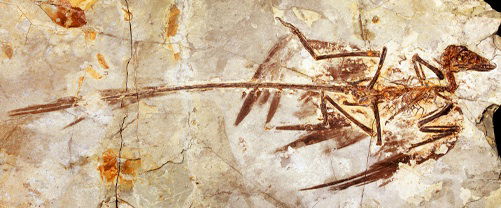
Feathered Fossil: Still a Bird
Glossy black flirt by any other name is still a bird.
News Source
- Futurity: “Four-winged dino lured mates with long tail”
Microraptor melanosomes (small packets of pigment) arrayed in fossilized feathers are comparable to those in iridescent black feathers of modern birds. Such is the verdict of a Chinese-American team after examining a fossilized “four-winged” Microraptor from Cretaceous rock in China’s Liaoning Province. The team does not believe the Microraptor could fly, so it needed an evolutionary excuse for the existence of well-developed feathers—a necessary step on the supposed evolutionary path to true bird flight. They therefore believe the Microraptor, which they consider a feathered dinosaur, evolved shiny feathers to attract mates. The attractiveness of such feathers, useless for flight they write, influenced “selection for aerodynamic attributes early in the evolution of birds.”1
“Most aspects of early dinosaur feathering continue to be interpreted as fundamentally aerodynamic, optimized for some aspect of aerial locomotion,” says co-author Julia Clarke. “Some of these structures were clearly ancestral characteristics that arose for other functions and stuck around, while others may be linked to display behaviors or signaling of mate quality.”
“Our evidence that Microraptor was largely iridescent thus suggests that feathers were important for display even relatively early in their evolution.”
“Modern birds use their feathers for many different things, ranging from flight to thermoregulation to mate-attracting displays,” adds co-author Matt Shawkey. “Iridescence is widespread in modern birds and is frequently used in displays. Our evidence that Microraptor was largely iridescent thus suggests that feathers were important for display even relatively early in their evolution.”
As microscopic pigment packets, melanosomes’ shape, density, and arrangement are related to the color and iridescent quality in modern feathers and therefore presumably in Microraptor feathers. The investigators compared melanosomes from the fossilized feathers with those of modern birds and thereby determined the Microraptor had “dark glossy plumage.”2

Feathered fossil—Is it a bird, or is it a dinosaur? Image courtesy of Futurity.
The new fossil, along with eight other Microraptor fossils discovered since 2003, has unmistakable feathers similar to the asymmetrically vaned flight feathers of modern birds. The Microraptor has two pairs of wings, the second pair being “hind limb feathers”3 in addition to a long thin tail plume with two long feathers at the tip. Paleontologists have debated about whether Microraptor was able to fly.
The authors of this study insist Microraptor could not fly based on their assessment of its anatomy. Co-author Mark Norell said, “Crows don’t have teeth. Crows don’t have claws on its hands. The hands are identical to things we think of as mean vicious animals, like velociraptor.”
Many evolutionists, like this team, believe the best Microraptor could manage was a glide from the treetops and consider the hind-most feathers to be an aerodynamic hindrance. However, since such fossils were produced by a crushing burial, the three dimensional structure of Microraptor is debated among experts. Some say modern birds have nothing resembling the Microraptor’s dragonfly-like hind wings, but others believe the three dimensional view would reveal these feathers “project backwards from the leg, much as do the relatively long leg feathers of many living raptors.”4—feathers which have no direct role in flight but do not hinder these hunters soaring to seek their prey.
While no living birds have teeth, the extinct bird Archaeopteryx had teeth, fingers on its wings, and a long tail.
While no living birds have teeth, the extinct bird Archaeopteryx had teeth, fingers on its wings, and a long tail. Another extinct bird, the Hesperornis, had teeth. The ostrich has fingers on is wings, and the young hoatzin of South America has fingers and toes with which it climbs trees. And while the feathers of this Microraptor have the same asymmetry seen in modern flight feathers, not all birds fly. Whether Microraptor actually flew or not is not relevant to its classification.
Since no definitive dinosaurs with feathers have appeared in the fossil record—only dinosaurs with fuzzy-looking collagen fibers that do not qualify in any way as transitional feathers—many evolutionists seeking to explain the evolution of feathers would like to find transitional evolutionary forms. Microraptor did not help their case. Instead, these feathers appear grossly and microscopically modern both in shape and microstructure. While the researchers in this study believe their specimen is a feathered dinosaur, they have only reaffirmed the lack of evidence for feather evolution in the fossil record by shining the spotlight on the essentially modern quality of these fossil feathers—supposedly 120–130 million years old.
Not all paleontologists agree with those who refuse to call Microraptor a bird. For instance, Professor Larry Martin of the University of Kansas said, “To me a bird is an animal with an avian hand and wrist with primary flight feathers. By that definition microraptor is definitely a bird.”5 Famous expert on bird evolution Alan Feduccia has said, “The microraptors of China are birds, regardless of their ancestry.” [quoted in Did Microraptor gui Invent the Biplane Before the Wright Brothers?]
God created “every winged bird according to its kind” (Genesis 1:21) on the fifth day of Creation week. He said, “Let birds fly above the earth across the face of the firmament of the heavens” (Genesis 1:20). The next day, God made each “beast of the earth, each according to its kind” (Genesis 1:24), including dinosaurs. Birds fully equipped to fly were flying the day before dinosaurs were even created.
Dinosaurs did not evolve into birds. Many anatomical differences between them make such a transition impossible. No genetic mechanism enabling an organism to acquire information to evolve into a completely new kind has ever been found. No evidence of feather evolution has been found in the fossil record or in this study. But thanks to this study, artists painting pictures of the world God made about 6,000 years ago can be reasonably confident as they make these birds shine in the sunlight of that first world.
Further Reading
- New Evidence Finds Dinosaurs Ate Birds
- Did Microraptor gui Invent the Biplane Before the Wright Brothers?
- Did Dinosaurs Turn into Birds?
- The Evolution of Feathers: A Major Problem for Darwinism
- Canadian Amber Holds Fuzzy Fossils
- Classic Black
- Oviraptor Flirting Techniques Revealed In Study
- Dinosaur-Bird Confusion
- Yet Another New “Feathered” Dinosaur?
For More Information: Get Answers
Remember, if you see a news story that might merit some attention, let us know about it! (Note: if the story originates from the Associated Press, FOX News, MSNBC, the New York Times, or another major national media outlet, we will most likely have already heard about it.) And thanks to all of our readers who have submitted great news tips to us. If you didn’t catch all the latest News to Know, why not take a look to see what you’ve missed?
(Please note that links will take you directly to the source. Answers in Genesis is not responsible for content on the websites to which we refer. For more information, please see our Privacy Policy.)
Footnotes
- Li, Quanguo et al. 2012. Reconstruction of Microraptor and the Evolution of Iridescent Plumage. Science 335:1215. DOI: 10.1126/science.1213780
- Ibid.
- Ibid.
- Menton, David. “Did Microraptor gui Invent the Biplane Before the Wright Brothers?” Answers in Genesis, February 21, 2007, https://answersingenesis.org/extinct-animals/did-microraptor-gui-invent-the-biplane/
- Borenstein, Seth. “Birdlike Dinos Wore Basic Black with Glossy Touch,” Yahoo! News, March 8, 2012, news.yahoo.com/birdlike-dinos-wore-basic-black-glossy-touch-201121628.html.
Recommended Resources

Answers in Genesis is an apologetics ministry, dedicated to helping Christians defend their faith and proclaim the good news of Jesus Christ.
- Customer Service 800.778.3390
- © 2024 Answers in Genesis





